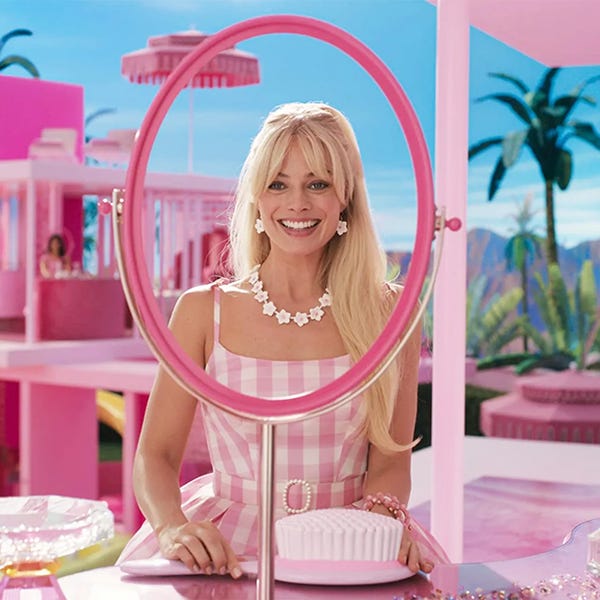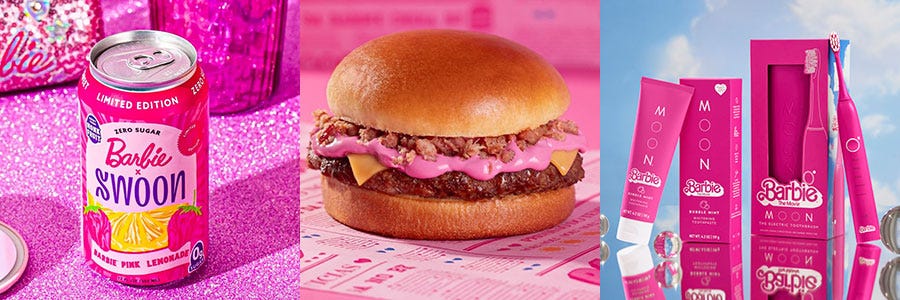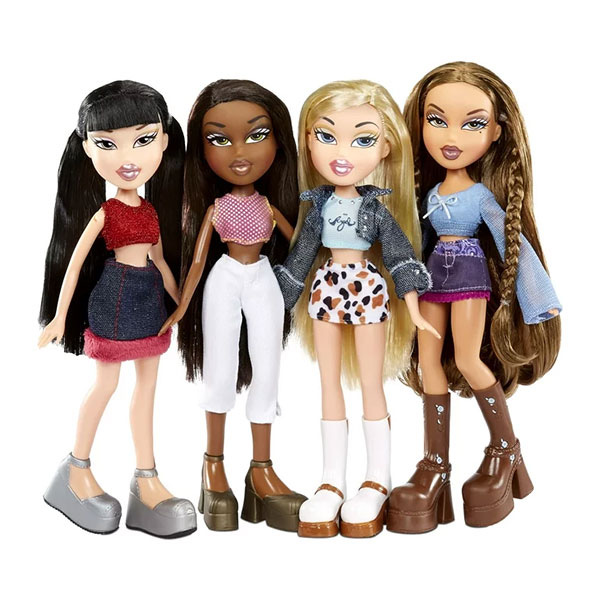Embracing Pink: Being a Barbie Fan and the End of the Guilty Pleasure
Unabashedly rediscovering the love of pop culture obsessions
As a child of the 80s, and a self-proclaimed girly-girl (for most of my childhood I refused to wear anything but dresses and skirts), I, like millions of girls before and after me, amassed a huge collection of Barbie dolls. I recently unearthed a giant tub of them I’d stored under my childhood bed at my parent’s house, and I found that I had more dolls and clothes than I actually remembered. As a kid I loved the dress up aspect of playing with Barbie: putting together outfits was (still is) one of my favorite things to do and I’ve never not been a sucker for a pretty ballgown (Taylor Swift and I have this in common), even if it’s for a doll.
If I think hard about it, it was really the clothes and the “lewks” I was into. I didn’t need Barbie to be an astronaut or a businesswoman or a doctor. I didn’t think about her aspirations. I thought about pairing the best accessories with a cute dress and styling her hair for a day at the Dreamhouse (*Note to Mom and Dad: I never got the Dreamhouse, and I’m not not still bitter about it.) This is to say, I didn’t think about my Barbie being smart or accomplished; I just wanted her to slay an outfit.
As a teen of the 90s and early aughts, there was a ton of media I consumed in a simplistic way. The media itself wasn’t simple (more on this later), but how little I critically thought about it was. And who could blame me? Popular culture was often regarded as unintelligent, vapid, unworthy of serious attention. As a girl who loved Britney Spears and *NSYNC and Dawson’s Creek, I often had to confess my interests to my peers with a reflective “I know, I know…” eyeroll. I actively let others know that I knew my interests weren’t “cool,” depending on who I was talking to. And I internalized that idea: my interests weren’t serious, and that somehow said something finite about how “cultured” and intelligent I was. It didn’t matter that I simply loved popular things. As a teenager growing up in a monoculture, it’s cool to not be into the thing everyone else is into.
During my freshman year at New York University, I sat in an English class with a professor who mentioned romance novels. When a few women in my class scoffed at the idea of taking modern smutty fiction seriously, my professor said, “just because it’s popular doesn’t mean it isn’t literature.” This sentence etched itself into my brain and has never let go (much like Rose promised Jack in yet another movie I had to apologize for loving all these years). The idea that something could be culturally important even though it’s popular was revolutionary to me. Later, when I worked on commercial novels inside the book publishing industry, I learned the truth: every author has engaged fans, whether their genre is “literary” or “romance” or anything in between.
However it wasn’t until Taylor Swift said, “And you would hide away and find your peace of mind/With some indie record that’s much cooler than mine” that I felt truly vindicated. I was a woman whose interests seemed unserious to the people I went to parties with who talked endlessly about indie music and movies as if they were the only “acceptable” fandoms to talk about. The dig at a man who would prefer an indie record to his girlfriend’s because it’s “cooler” was the exact kind of schadenfreude I live for: joke’s on him, because the odds are that billions of people will hear the song taking a jab at him, precisely because Taylor Swift’s music is not “indie.”
Like everyone else this summer, I saw the Barbie movie. (I actually saw it three times, once in IMAX, of course.) Going into it, I knew we were in for something extraordinary; I would expect nothing less from Greta Gerwig and Margot Robbie. While many of my friends and I were excited to see it, I also had conversations with female friends who said “I have no interest in seeing that movie.” I tried to get to the bottom of why: was it because it was a big brand (decidedly not “indie,” which we decided as a culture decades ago is the only “cool” kind of fandom to consume)? Was it because they didn’t care for Barbie dolls as a child? Was it an inherent dislike of all things pink and overly feminine? After all, pink is the color of girl and womanhood (though it wasn’t always that way).
The marketing of the movie was everywhere: from brands promoting signature pink product collaborations to Airbnb offering a stay in a real Barbie Malibu Dreamhouse, it was hard to miss the fervor with so many product collaborations–both official and unofficial–out there. Looking back on the promotion of this movie having seen it, it’s difficult not to see the brilliance: one of the things that the movie does is use the idea that consumerism is an inescapable part of our lives, for better or worse. Leaning into that with a barrage of collaborations makes a lot of sense in hindsight.
And with all of this brand saturation in the market, something else extraordinary happened: moviegoers (many of whom were likely primed from attending Taylor Swift’s Eras Tour all summer in amazing outfits and costumes) showed up in their best Barbie-inspired looks. From full out costumes based on real dolls to wearing lots of pink and sparkly flair, moviegoers (mostly women) showed up to movie theaters dressed to impress. For anyone who dressed up to sit in a dark movie theater, it was a way to get back into the mindset of the inner child who played with Barbie long ago.
In the film (spoilers ahead!), Barbie is living her best life in Barbieland wearing great clothes and partying with the other Barbies and Kens. Crisis strikes when her signature permanent tiptoe falls flat, signifying that something is askew with the person who is playing with her in the Real World. So, she journeys there to find the person and make things right. She meets young Sasha and a gaggle of Bratz-doll looking classmates.
The Bratz dolls, famously, were marketed in opposition to Barbie; they gave an alternative vibe that seemed less perky to our mainstream all-American pink-loving enthusiast. Sasha accuses Barbie of “destroying girls’ innate sense of worth” and glorifying “rampant consumerism.” While watching, I thought about all those Barbie clothes I had, and how I still love shopping for the perfect outfit: I felt seen. But not in a great way; a cringey one. Sasha would likely hold me up as an example in her Barbie takedown. Barbie herself goes off to cry, and process this information.
Living in a world of contradictions as a woman is exhausting, as Gloria’s deeply touching speech in the movie illuminates.
Feminism is an often debated concept; is it more feminist to eschew all things pink (it was when I was in high school) or to embrace it unapologetically? Contradictions seem to be everywhere when we talk about feminist ideas, and that’s why it’s usually complicated to discuss. The fashion industry is full of extraordinarily talented artists and shrewd business leaders, but a girl being obsessed with clothes, like Barbie, is seen as vapid. Sasha’s words, while also mocking Barbie’s pink western outfit (spectacularly put together by costume designer Jacqueline Durran), cut pretty deep.
However when Barbie realizes it’s not Sasha, but her mother Gloria who is playing with her in the Real World, things in the film shift. Gloria looks back on her time playing with Barbie with her daughter (and likely on her own too) as a time of unfettered hope and positivity about what is possible for a woman. And it isn’t just about career aspirations: clothes we feel great in are part of it.
The first time we see Gloria’s full outfit, I noticed immediately that she wears a pink sparkly belt. (Similarly, in the touching bench scene, the older woman that Barbie calls “beautiful” is wearing a glittery headband.) There seems to be a commentary here about reclaiming pink, sparkly fashion choices, the ones women were likely drawn to as children, and forced to give up in their adulthood as they struggled to be taken seriously by peers and colleagues. It’s a subtle use of costume in a film that takes costumes to the next level, but the impact for me, and the little girl I was who loved clothes for my dolls more than Barbie’s career aspirations, was monumental.
Suddenly, the costumes theatergoers wore to see the movie seemed not like a regression to remember girlhood, but a celebration of current womanhood. In the final scene of the movie, Gloria says that the ordinary woman just wants to “wear a flattering top and get through the day.” The idea that women might disproportionately be obsessed with clothes (that “rampant consumerism” jab that Sasha lobs at Barbie) is seen for what it really is: an attempt to feel one’s best and most confident, which can often be attained through a fantastic jacket. Ken sure knows this when he dons that amazing Stallone-inspired fur coat. (Podcaster Kate Kennedy noted on her episode of Be There in Five titled “Life in Plastic, It’s Scholastic” that in Kendom, a simulation for what Ken thinks is patriarchy in the Real World, the men get to keep their toys, like trucks, in adulthood, while women in the Real World always give them up as they “outgrow” them in an effort to be taken more seriously.)
I left the theater–all three times–feeling regretful about all the fandom I apologized for enjoying in the past, including Barbie dolls. The idea of “guilty pleasures” in fandom is one I would love to see go away forever: if it is something you enjoy, why let others’ opinion deter you or apologize for it? As my professor said, just because something is popular doesn’t mean it’s not legitimate, or even intellectually valuable. And this is one of the many ideas that Barbie sets out to address. Both in the film itself, and because of its existence. One of my favorite things to hear is that someone was surprised by the movie, that it wasn’t just the bubblegum light-hearted romp about a doll universe they expected, but it is that AND an introspective look at society and identity. Two things can be true at the same time.
So as I add Britney Spears’ memoir to my to-be-read list and gear up for the inevitable *NSYNC reunion, I’ll be doing so proudly. Thanks to Barbie, and the Barbie movie, both of whom made it very normal to wear a pink glittery belt to work in middle age and unabashedly celebrate my fandoms.
Want more?
Come join us on our discord where you can find fans just like you who love all kinds of content from all nations! You can schedule chat sessions or watch parties around your favorite TV shows & movies in our app, and follow us on Instagram and Tumblr for more fannish content!










